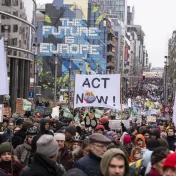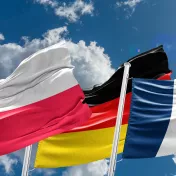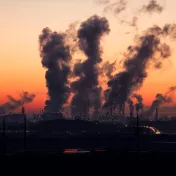The EU Emissions Trading System for buildings and transport (ETS2) is hanging in the balance: several Member States want to postpone its launch by a year, thereby jeopardising this key instrument of European climate policy. Instead of further delaying its launch, what is needed now is a gradual introduction, targeted support for the countries affected, and clear responsibility, including from Germany.
One of the flagships of EU climate policy hangs in the balance
During a late-night meeting of the Environment Council on 4–5 November, in which EU climate targets for 2035 and 2040 were discussed, a few Member States managed to add a proposal to the final text to postpone the Emissions Trading System for buildings and road transport (ETS2). Governments are demanding that the system be introduced one year later, in January 2028. Although the delay is not yet legally binding, the reactions speak volumes: defeatism, shrugging shoulders, and in some cases, relief.
EU Commissioner Wopke Hoekstra now faces only bad options:
- If he ignores the Council, discontent among skeptical governments will grow.
- If he agrees to the Council’s proposal and delays the start, he will face criticism, as this is not provided for in the directive.
- If he actually reopens the ETS Directive, further weakening beyond the postponement looms.
He now needs to get creative and offer more than he had originally planned. A new proposal needs to hit the mark – otherwise, we may not see ETS2 even in 2028. ETS2 is facing an existential threat.
Just days earlier, Hoekstra had tried to calm nerves by making far-reaching concessions to skeptical Member States, agreeing to lower ETS2 prices well into the mid-2030s. Through an expanded Market Stability Reserve (MSR), the number of emission allowances would increase by up to 8% in the coming years, aiming to contain the price at around €65 initially. But even this prospect was not enough for some governments. They now demand that Hoekstra reopen not only the MSR decision but the entire ETS directive.
Adding to the challenge, Member States can simply choose not to implement ETS2 at the outset. Why would they fear an infringement procedure? It’s hard to imagine a new Czech government under Andrej Babiš – elected on an anti-Green Deal platform – implementing ETS2 anytime soon, even in 2028. Poland’s government under Donald Tusk has already signalled it is not a supporter and wants a three-year delay. Romania has just decided to introduce ETS2 only in 2031. Italy and France are also far from certain candidates.
It is time for fresh proposals to ensure that an effective emissions trading system is launched as soon as possible.
Phase-in model instead of blanket postponement
A simple one-year delay of ETS2 is not enough if Member States do not actively prepare for implementation. Without targeted measures, there is a risk that today’s challenges will repeat themselves in 2028 – especially since postponement offers no guarantee that skeptical states will adopt the system then. ETS2 should therefore launch as planned in 2027 in countries that are ready for or already have CO₂ pricing – such as Germany, the largest emitter in the ETS2 sector.
For a limited number of Member States, a phase-in model could be a pragmatic solution. These are countries which currently raise no or only very low CO₂ prices in buildings and transport. Unlike Germany, they will face a sudden and significant price hike for gasoline, gas, and coal when the system is introduced – a situation that could fuel populist and often anti-European parties, further weakening the EU. It is no coincidence that most of these states are the strongest critics of ETS2. A gradual introduction would bring a country up to the prevailing ETS2 price over a period of, say, three years, based on criteria such as per-capita income, expected price increases, or the number of vulnerable households. At the same time, targeted support measures during the phase-in must be ramped up to accelerate the switch to climate-neutral heating and transport and to cushion social hardship.
Solution-oriented dialogue and better communication for a fair ETS2
The EU Commission should now actively engage with countries under particular political pressure – for example those facing elections – or those most affected by ETS2’s social impacts, like Hungary, Bulgaria, and Poland.
As part of technical and social support for the implementation of the directive, the Commission could work with Member States to identify the conditions under which they would constructively implement ETS2. For example: would an increase in the Social Climate Fund with adjusted distribution criteria boost public acceptance? Could temporary partial exemptions with minimal impact on total emissions secure agreement? The goal must be to preserve the instrument’s effectiveness – not to hollow it out.
Moreover, the Commission should significantly step up its public communication. It must clearly convey that ETS2 will generate substantial revenues, which should be used to relieve households beyond the Social Climate Fund. Communication should be practical and easy to understand, illustrating investments’ cost benefit for households and small businesses. It should include concrete examples, for example how buying a heat pump pays off over time. This can strengthen public acceptance and encourage active participation.

Scharfsinn86 | Getty Images
If the market delivers less, other instruments must deliver more
Part of the solution to the ETS2 crisis lies in additional supporting instruments: financing and regulatory measures. Financing means using resources from the Social Climate Fund and further ETS2 revenues strategically. This includes grants for building renovations or expanding programs such as Germany’s federal funding for efficient buildings, social leasing for electric vehicles, or a nationwide social transport ticket. Without early reinforcement or introduction of such instruments, public acceptance of ETS2 will continue to decline.
And yes, regulation seems to be controversial at the moment – but unavoidable. If the market mechanism delivers less reduction, binding standards must step in. This includes emission standards for cars and trucks. The upcoming proposal for corporate fleets must be robust. Here’s the irony: the German Association of the Automotive Industry (VDA) loudly complains about ETS2 delays because it knows what that means – every year without ETS2, the emission standards have to deliver more reductions. Lobbying against emission standards has, in turn, helped put ETS2 under pressure.
Moreover, we need ‘price action triggers’ to respond to market disruptions in a targeted way. If, as recently proposed by the EU Commission, additional allowances are inserted into the market via the Market Stability Reserve (MSR), these measures must be tied to further obligations for Member States to reduce emissions in different ways. Otherwise, climate targets will be jeopardised, and ETS2 prices will rise sharply in the coming years. When the MSR kicks in, EU countries should, for example, present additional support programs for switching to climate-neutral mobility, demonstrably accelerate building renovation plans, or actively advance infrastructure expansion through concrete projects. Without these measures, the real ETS2 price will not fall – regardless of how many additional certificates are issued.
Germany must not outsource responsibility for emission reductions
ETS2, like any heterogeneous single market, has centrifugal effects: it hits harder in countries with lower per-capita incomes than in wealthier ones. While a household in Germany may only feel moderate additional fuel costs, a family in Poland – especially if they still heat with coal (which affects over three million households) – will feel the new CO₂ price many times more.
But Germany also bears a special responsibility for price pressure and acceptance in Poland: Germany is the largest emitter in the ETS2 sector and currently has an emissions reduction gap in the Effort Sharing area (transport and buildings) that is expected to grow to 64 million tons by 2030 – and so far, concrete measures to close this gap are missing. EU-wide, the gap in the ‘with additional measures’ (WAM) scenario is ‘only’ 50 million tons. In other words: whether Effort Sharing targets are met depends largely on Germany – and thus also on how high ETS2 prices will be across Europe.
This is a question of intra-European fairness, at least from the perspective of other EU countries. Therefore, another piece of the necessary response is to quickly adopt an effective climate protection programme (‘Klimaschutzprogramm’) in Germany to close this gap. As one measure, the federal government should introduce a national minimum price for greenhouse gases – not least to avoid a collapse in price incentives and revenues for the Climate and Transformation Fund if the ETS2 price falls below the preceding German level.
If clear rules and decisive steps fail to materialise today, valuable years will be lost. Every further delay means: more emissions, rising social costs – and a creeping loss of trust in European climate policy. ETS2 must now be gradually implemented and socially supported.







